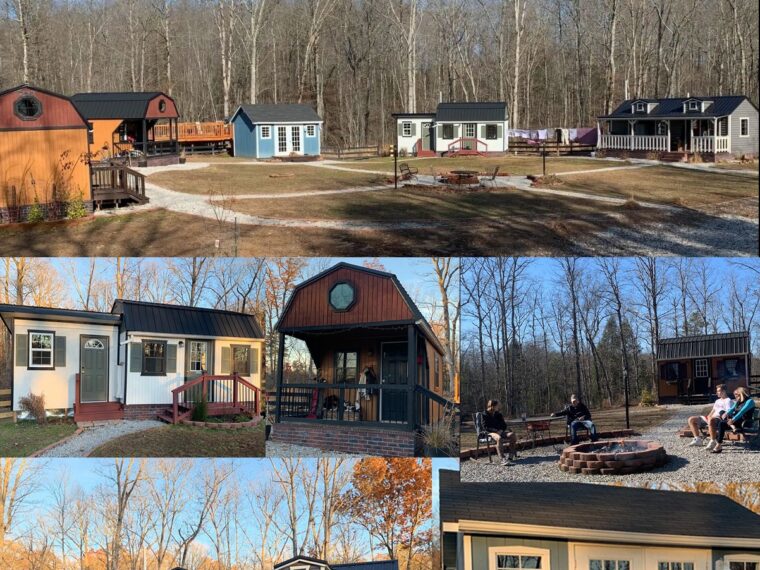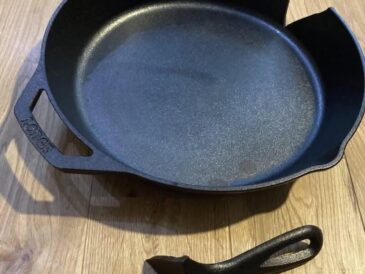Tiny homes have become increasingly popular over the past decade, offering an alternative to traditional housing that emphasizes simplicity, sustainability, and financial freedom. But what happens when a family takes this trend a step further — and instead of just one tiny home, they create an entire village of tiny homes on their own land?
This is exactly what Keli and Ryan Brinks did. In 2015, the adventurous couple purchased 21 acres of rural land in London, Kentucky, and established a unique living arrangement: a tiny house village with six small structures spread out across the property. Today, each family member has their own private tiny home, including Keli and Ryan themselves, their 18-year-old daughter Lennox, and their 16-year-old son Brodey. The remaining structures serve other purposes like a shared hangout space and office.
This family’s journey toward tiny living is inspiring, showcasing how downsizing can actually create more freedom, togetherness, and sustainability. Let’s dive into how the Brinks family made this tiny home village dream a reality — and how they’re thriving in their unconventional lifestyle.
Why London, Kentucky?
When Keli and Ryan decided to leave behind traditional homeownership and downsize, location was a critical factor. They settled on London, Kentucky, primarily because of two reasons: affordable land and minimal housing restrictions.
“We purchased 21 acres for just $57,000,” Keli explains. “Compared to other nearby areas, especially in Tennessee where family lives, land was much more expensive and had strict regulations on housing types. Here, we had more freedom to build the kinds of homes we wanted without endless red tape.”
The rural setting offered plenty of privacy and space for their tiny home village concept. Instead of crowding into a single house, each family member could have their own small sanctuary with shared common areas. Plus, the countryside lifestyle suited their goal of living sustainably and closer to nature.
The Tiny Homes: A Tour of the Village
Keli and Ryan’s Home — The Family Hub
At 280 square feet, Keli and Ryan’s tiny home is the largest structure on the property and serves as the family’s main residence. It includes a cozy living area, a fully functional kitchen, a bathroom, and a loft bedroom.
Though compact, the space is designed with smart storage solutions and multi-purpose furniture, making the most of every inch. Natural light floods in through large windows, and neutral tones give the home an airy, comfortable feel.
“It’s small, but it’s home,” Ryan says. “We love how efficient it is and how it forces us to be intentional about what we keep.”
The Kids’ Tiny Homes and Shared Bathrooms
Next door, the family built a separate tiny structure that houses two side-by-side bathrooms, each assigned to one of the children. This setup gives Lennox and Brodey privacy while still centralizing plumbing and utilities to one building.
Adjacent to the bathrooms is a guest bedroom space that can accommodate visitors or family staying overnight. This is especially useful for holidays or weekends when Lennox, currently a college student, comes home from school to spend time with her family.
The Pool House: Family Gathering Spot
One of the standout features of the property is the “pool house,” a tiny building dedicated to family hangouts and entertainment. This cozy space includes seating areas and games where the Brinks family can relax together, away from their individual tiny homes.
The pool house opens up to an above-ground swimming pool and wooden deck, a perfect spot for summer fun and bonding. On warm days, this area becomes the heart of the tiny village.
Brodey’s Tiny Home
Brodey’s house is designed to maximize comfort in a small footprint. It includes a porch for enjoying the outdoors, a living space downstairs, and a loft bedroom upstairs. The porch especially allows Brodey to connect with nature and neighbors, blending indoor and outdoor living.
Lennox’s Tiny Home
Though Lennox currently spends much of her time away at college, she has her own tiny home on the property. On weekends and holidays, she returns to this private space where she can relax independently but still be close to family.
Additional Structures and Farm Life
In addition to the five main tiny homes, the property features a sixth, very small structure serving as a home office for Ryan, who works remotely. This separation of work and living space helps maintain a healthy work-life balance.
The family also maintains a small barn, a chicken coop, and raises a goat — part of their commitment to sustainable, semi-self-sufficient country living. Fresh eggs, occasional goat milk, and garden harvests supplement their food supply, reducing reliance on supermarkets and lowering their environmental footprint.
Why They Chose Tiny Living
For the Brinks family, transitioning to tiny living wasn’t just about saving money or following a trend — it was a lifestyle choice rooted in values of sustainability, simplicity, and family connection.
Sustainability
Keli emphasizes their commitment to “refuse, reduce, reuse, recycle.” Their small homes require far less energy to heat and cool, and they pay only about $200 per month in utilities for the entire village — a remarkable feat compared to the average American household.
They carefully manage waste, compost organic materials, and prioritize secondhand and repurposed furnishings. Living small has made them hyper-aware of their consumption and environmental impact.
Financial Freedom
The cost savings from buying inexpensive land and building affordable tiny homes has allowed the family to avoid traditional mortgage debt. Ryan points out, “Because our homes only cost around $20,000 each to build, we can invest our money in experiences and family instead of paying off a huge mortgage.”
Closeness Without Clutter
One might assume that living in tiny homes on the same property would feel cramped, but the Brinks family finds the opposite to be true.
“We have our own space when we want it, but it’s easy to come together for meals, pool time, or just hanging out,” Keli says. “There’s a nice balance between independence and community.”
Challenges and Adaptations
Of course, tiny living isn’t without its challenges. The family has had to learn to live with less, be mindful about storage, and accept the quirks that come with small spaces.
Ryan jokes, “We joke that the biggest challenge is making sure we don’t lose each other in the woods!” Since the homes are separate structures spread out on a large property, staying connected requires some coordination.
Additionally, seasonal weather can impact comfort and maintenance. Kentucky winters can be chilly, so the tiny homes are well-insulated and equipped with efficient heating systems.
The Future of the Village
The Brinks family’s tiny home village is still evolving. With plenty of land, they have plans to expand or add new structures if desired. As Lennox finishes college and decides on her next steps, the flexibility of having her own home on the property will offer stability.
Ryan and Keli also hope their village can serve as inspiration for others considering alternative housing options.
“We want people to see that tiny living doesn’t mean sacrificing quality of life,” Ryan explains. “It’s about redefining what home means and making conscious choices that work for your family.”
Why This Matters Today
The Brinks family story resonates in a world where housing costs continue to soar and people seek more sustainable, intentional lifestyles. Tiny homes offer a viable alternative for reducing environmental footprints, living debt-free, and fostering closer family ties.
Their tiny house village challenges the notion that bigger is always better. Instead, it celebrates a way of life that embraces less stuff, more nature, and quality time with loved ones.
Final Thoughts: Could You Do It?
For many, the idea of downsizing to a tiny home — or a whole village of them — might seem daunting or impractical. But the Brinks family shows that with creativity, commitment, and a clear vision, it’s possible to build a fulfilling life on your own terms.
Whether it’s the joy of personal space, the freedom from financial stress, or the connection to the land and family, their tiny home village stands as a beautiful example of alternative living done right.
So, what about you? Could you imagine trading the sprawling suburban house for a tiny home village with your closest family? The Brinks family invites us all to rethink home, community, and the future — one tiny house at a time.





